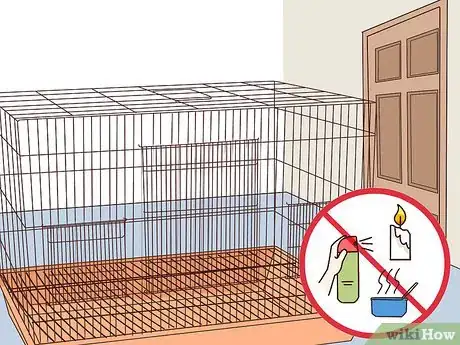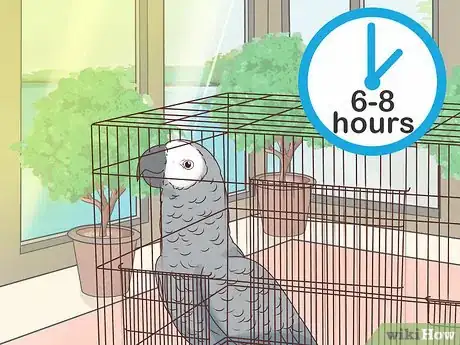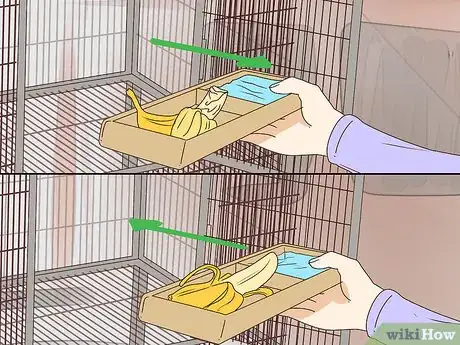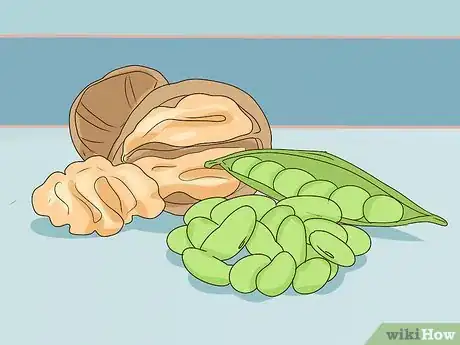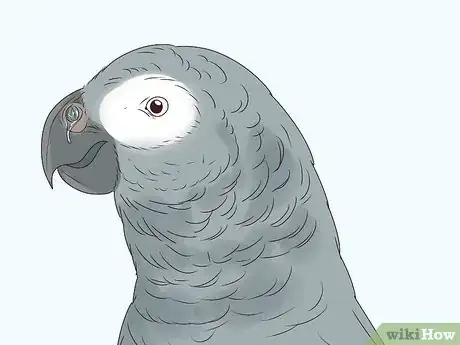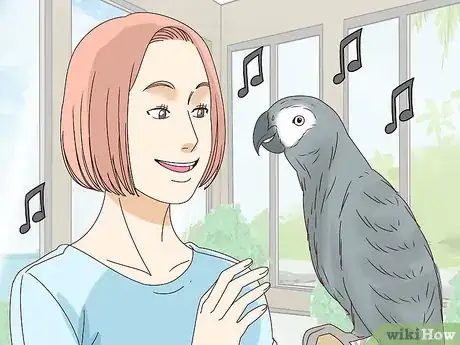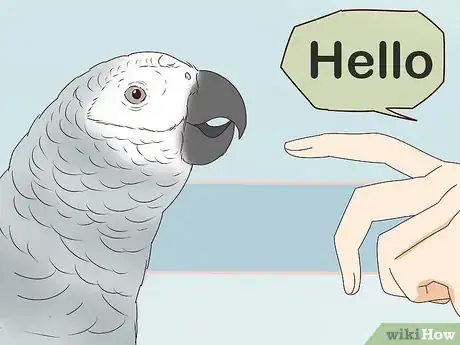This article was co-authored by Hayley Heartfield. Hayley Heartfield is a Bird Specialist and the Owner of About Birds, a Pet Bird Shop in Montgomery County, Texas. Hayley specializes in pet bird care, behavior, training, and breeding. Hayley studied Animal Science at Texas A&M. About Birds carries many species of birds and offers grooming and boarding services as well as bird care products.
wikiHow marks an article as reader-approved once it receives enough positive feedback. In this case, 100% of readers who voted found the article helpful, earning it our reader-approved status.
This article has been viewed 40,728 times.
African grey parrots are intelligent, social birds that require lots of attention. To provide the right environment, house your bird the largest enclosure possible with plenty of fun perches and toys. African greys love spending time with their owners, so be sure to give your pet the social interaction it needs. While they’re not the easiest pet to raise, their lifelong companionship is well worth the effort. By providing the proper care, you can help your feathered friend live a long, happy, and healthy life!
Steps
Housing Your Parrot
-
1Keep your parrot in the largest enclosure possible. At a bare minimum, select a cage that’s at least 2 by 3 by 4 feet (0.61 by 0.91 by 1.22 m). Keep in mind bigger is better, so go with the largest cage your home and budget can accommodate.
- Line the bottom of the cage with paper bedding, which is safer and more affordable than corn, cedar, and pine shavings.
- Avoid cages that are coated with zinc or lead, as these metals are toxic to birds.
-
2Place the cage away from kitchen fumes, air fresheners, and candles. Choose a draft-free spot that gets ample natural light. Since parrots have sensitive airways, avoid exposing your bird to fumes released by cleaning products, air fresheners, and cooking. Additionally, don’t smoke around your African grey.[1]
- Your parrot won’t like drafts or sudden changes in temperature. As long as you place the cage away from doors or ill-fitting windows, you shouldn’t need any special equipment to control the temperature, which should stay between 65 and 85 °F (18 and 29 °C).
Advertisement -
3Make sure your parrot gets 6 to 8 hours of sun per day. Parrots need plenty of sunlight to meet their vitamin D and calcium needs. If you can’t place the cage in a spot that gets lots of sun, install a full-spectrum UV light above the cage. Keep the light on for 6 to 8 hours per day.[2]
- Purchase a UV light online or at a pet store. It’s wise to place a thermometer next to the cage to ensure the temperature stays under 85 °F (29 °C). Just make sure the thermometer is out of the reach of your inquisitive parrot’s beak and talons.
-
4Provide a variety of perches and toys to keep it entertained. Distribute least 2 to 3 perches around the cage at various heights to enrich your parrot’s environment.[3] In addition, keep your bird occupied with store-bought puzzle and chew toys, pieces of cardboard or egg carton, and non-toxic wood scraps.[4]
- Choose perches with interesting textures that mimic natural branches instead of straight plastic ones, which parrots find boring. Store-bought manzanita wood perches are safe, entertaining options.
- Rotate the toys you keep in its cage so your parrot doesn’t get bored.
- African greys love shredding toys since they have destructive tendencies.[5]
Safety tip: Avoid using branches from your yard, which may be toxic or coated with harmful chemicals. Steer clear of poisonous woods and plants, including azalea, cedar, and oak.
-
5Clean your parrot’s cage regularly. Spot clean the enclosure daily by removing waste, replacing soiled bedding, and cleaning food and water bowls. Once a week, place your parrot in a secondary cage, remove everything from the main cage, and wash the enclosure with soap and hot water.[6]
- Scrub any caked-up debris on the cage's bars and floor, and be sure to thoroughly rinse away soap residue. Dry the cage when you’re finished, then add fresh bedding.
- You should also wash your parrots toys and perches when you deep clean the cage.
- Be sure to wash your hands thoroughly for at least 20 seconds after cleaning the cage, handling your parrot, or touching anything inside the cage.
Providing Food and Water
-
1Make sure your bird has access to clean fresh water at all times. Use a heavy water bowl to prevent spills; choose one with a wide rim so your bird can bathe. Change the water and clean the bowl at least once a day, or whenever it becomes soiled.[7]
- If your tap water is high in minerals, offer your pet filtered or bottled water.
-
2Offer ¼ to ½ cup (85 to 170 g) of commercial parrot food per day. Commercial parrot pellets should comprise about 75% of your pet’s diet. The exact amount depends on the brand and your bird’s size, so read your product’s instructions. Place a daily portion in the cage each morning; use a heavy bowl that your bird can’t knock over.[8]
- At night, discard uneaten food and clean the food bowl with soap and hot water to prevent bacterial growth.
- Feeding your pet commercially prepared bird food will help ensure it meets its nutritional needs. Avoid feeding your parrot a diet of mainly seeds and nuts, which would lead to obesity and nutritional deficiencies.
-
3Supplement its diet with fruits, veggies, and well-cooked meat. Wash fruits and veggies thoroughly, cut a 1 to 2 tablespoon (10 to 20 g) portion into bite-sized pieces, and place them in your parrot's cage in the morning. Good produce choices include kale, carrots, mustard greens, cabbage, broccoli, oranges, apples, and seedless grapes.[9]
- African greys need more protein than other parrots, so you should also offer a 1 inch (2.5 cm) piece of well-cooked scrambled eggs, chicken, or fish 1 to 2 times per week.[10]
- Offer fresh foods and parrot pellets in separate dishes. Remember to discard uneaten food and wash food bowls at the end of the day.
- Put the food in foraging toys to help them think.[11]
Avoid harmful foods: Toxic items include avocados, dairy products, chocolate, and uncooked meat and eggs. Additionally, avoid feeding your parrot table scraps, which could lead to obesity.[12]
-
4Give your African grey treats in moderation. Treats, such as nuts and seeds, should comprise no more than 5% of your parrot’s diet. Tasty seeds and nuts are great for training and rewarding your pet, but too many treats are unhealthy.[13]
- To provide mental and physical exercise, hide treats around your parrot’s enclosure. Encouraging your bird to forage can help prevent behavioral issues.
- Avoid keeping a bowl of seeds and nuts in the enclosure or otherwise giving your pet unrestricted access to treats. It’ll fill up on seeds and nuts and ignore its regular food.
Keeping Your Bird Happy and Healthy
-
1Find a local exotic pet vet with experience caring for parrots. Not all small animal vets are experienced with birds and other exotic animals. Look online or ask the store or breeder that provided your parrot to refer you to a vet who can meet your parrot’s needs. To keep your bird healthy, schedule checkups at least once a year.[14]
- When you look online for a vet, use the search terms “exotic animal vet” and “avian vet” plus your location.
-
2Check your bird for signs of illness regularly. Every week or so, check your African grey’s eyes and nostrils for redness or discharges. Look for discolored or broken feathers, and check the skin on its feet for blemishes. Listen to its breathing, and make sure it doesn’t wheeze or sound labored.[15]
- Additionally, check its feces routinely, and note any changes in color or consistency. If you spot any concerning symptoms, give the vet a call.
- African greys are generally healthy and long-lived, but they are prone to respiratory disorders and other issues. Regularly checking your pet and routine veterinary care can help you spot any issues as early as possible.
-
3Spend lots of time with your parrot to strengthen your bond. African greys are social animals, so spend plenty of quality time together. Each day, play with it, scratch its head gently, sing to it, and talk to it. Even simply sitting by its cage can give your parrot the social interaction it needs.[16]
- Spending time with your parrot especially important during the first 1 to 2 years of its life. During this time, do your best to avoid leaving your bird alone for more than a few hours at a time.
Handling a parrot properly: Parrots enjoy being stroked from the top of the head toward the beak. Avoid petting your bird from its head to its tail. If you need to take your pet out of its cage, grasp its body firmly but gently. If necessary, hold it in a towel or blanket to contain its wings.
-
4Train your parrot how to talk to give it mental stimulation. African greys are highly intelligent and among the most skillful talkers. When you begin training, teach your parrot simple, short words, such as “Hello” and “Bye bye.” Repetition is key, so say the word over and over in a high, enthusiastic pitch.[17]
- Repeat the word 5 to 6 times, offer a small treat, then take a break. Have patience, it may take anywhere from several days to a few weeks before your parrot repeats a word.
- When it does speak, offer its favorite treats and heap on the praise.
Expert Q&A
-
QuestionHow can I make my African grey parrot happy?
 Hayley HeartfieldHayley Heartfield is a Bird Specialist and the Owner of About Birds, a Pet Bird Shop in Montgomery County, Texas. Hayley specializes in pet bird care, behavior, training, and breeding. Hayley studied Animal Science at Texas A&M. About Birds carries many species of birds and offers grooming and boarding services as well as bird care products.
Hayley HeartfieldHayley Heartfield is a Bird Specialist and the Owner of About Birds, a Pet Bird Shop in Montgomery County, Texas. Hayley specializes in pet bird care, behavior, training, and breeding. Hayley studied Animal Science at Texas A&M. About Birds carries many species of birds and offers grooming and boarding services as well as bird care products.
Bird Specialist Provide an enriching habitat with lots of different toys and perches, which will help keep it occupied.
Provide an enriching habitat with lots of different toys and perches, which will help keep it occupied. -
QuestionWhat toys do African grey parrots like?
 Hayley HeartfieldHayley Heartfield is a Bird Specialist and the Owner of About Birds, a Pet Bird Shop in Montgomery County, Texas. Hayley specializes in pet bird care, behavior, training, and breeding. Hayley studied Animal Science at Texas A&M. About Birds carries many species of birds and offers grooming and boarding services as well as bird care products.
Hayley HeartfieldHayley Heartfield is a Bird Specialist and the Owner of About Birds, a Pet Bird Shop in Montgomery County, Texas. Hayley specializes in pet bird care, behavior, training, and breeding. Hayley studied Animal Science at Texas A&M. About Birds carries many species of birds and offers grooming and boarding services as well as bird care products.
Bird Specialist African grey parrots really enjoy shredding and foraging toys. You can also keep things interesting by rotating out their toys and switching the toy placements around in the cage.
African grey parrots really enjoy shredding and foraging toys. You can also keep things interesting by rotating out their toys and switching the toy placements around in the cage. -
QuestionCan my female cockatiel raise a baby African grey parrot from an egg?
 Community AnswerNo, a bird won't raise a chick that isn't its own. It is crucial for only the mother to take care of the egg, unless she can't for some reason. Also, an African grey parrot requires a lot more care than a cockatiel, so it is difficult to keep them together.
Community AnswerNo, a bird won't raise a chick that isn't its own. It is crucial for only the mother to take care of the egg, unless she can't for some reason. Also, an African grey parrot requires a lot more care than a cockatiel, so it is difficult to keep them together.
Warnings
- Be sure to obtain an African grey from a reputable breeder or pet store. Avoid purchasing exotic pets that were illegally sourced from the wild.⧼thumbs_response⧽
- Avoid placing your fingers near your bird’s beak. A parrot’s beak is powerful and could break or crush a finger.⧼thumbs_response⧽
- Do not let your African Grey go near pools or tubs unaccompanied to prevent drowning.⧼thumbs_response⧽
- It is recommended you clip your African Grey's wings so they cannot fly. Otherwise, do not forget to turn your ceiling fan off if your African Grey is not in a cage to prevent injury or death to your African Grey.⧼thumbs_response⧽
References
- ↑ https://www.bbc.co.uk/programmes/articles/cgKTHP9Sn4gCf6FN256pW2/user-guide-parrots
- ↑ https://www.bbc.co.uk/programmes/articles/cgKTHP9Sn4gCf6FN256pW2/user-guide-parrots
- ↑ Hayley Heartfield. Bird Specialist. Expert Interview. 23 June 2021.
- ↑ http://www.avianandexotic.com/care-sheets/birds/african-grey/
- ↑ Hayley Heartfield. Bird Specialist. Expert Interview. 23 June 2021.
- ↑ https://www.bbc.co.uk/programmes/articles/cgKTHP9Sn4gCf6FN256pW2/user-guide-parrots
- ↑ https://www.bbc.co.uk/programmes/articles/cgKTHP9Sn4gCf6FN256pW2/user-guide-parrots
- ↑ https://vcahospitals.com/know-your-pet/african-grey-feeding
- ↑ https://vcahospitals.com/know-your-pet/african-grey-feeding
- ↑ https://www.parrots.org/ask-an-expert/guidelines-for-rearing-a-young-african-grey
- ↑ Hayley Heartfield. Bird Specialist. Expert Interview. 23 June 2021.
- ↑ https://www.bbc.co.uk/programmes/articles/cgKTHP9Sn4gCf6FN256pW2/user-guide-parrots
- ↑ http://www.avianandexotic.com/care-sheets/birds/african-grey/
- ↑ https://vcahospitals.com/know-your-pet/african-grey-feeding
- ↑ http://www.avianandexotic.com/care-sheets/birds/african-grey/
- ↑ https://www.parrots.org/ask-an-expert/guidelines-for-rearing-a-young-african-grey
- ↑ http://www.vetstreet.com/our-pet-experts/10-tips-to-help-teach-your-parrot-to-talk
About This Article
To raise an African grey parrot, buy a roomy enclosure and line the bottom of the cage with paper bedding. Next, position the cage in a sunny, draft-free spot away from kitchen fumes, air fresheners, and candles. Then, put at least 2-3 perches in the cage and add several toys to keep the parrot occupied. Make sure your bird has access to clean water at all times and feed it ¼ to ½ cup of commercial parrot food daily. For tips on socializing and bonding with your African grey, read on!

